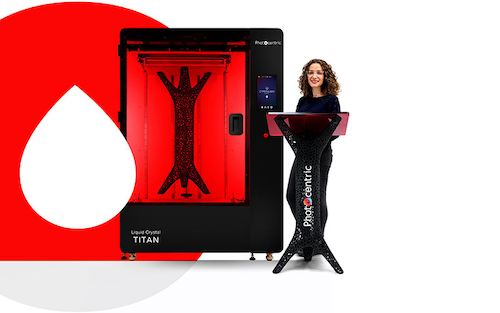Up until now, printing very large parts has been costly, slow, and problematic. Large format 3D printers, their software, maintenance and consumables are extremely expensive, and the finish can still be rough, requiring a lot of post-processing. With these challenges in mind, Photocentric recently launched the world’s largest LCD printer, Liquid Crystal Titan.
Titan’s build volume of 695 x 385 x 1200mm is more remarkable in that it has a pixel pitch of just 91 microns across the entire area, delivering phenomenal final part resolution. Because it uses LCD, it hardens a large area simultaneously. The 8k (7660 x 4320 pixels) screen provides control of over 33 million pixels, allowing the user to convert huge amounts of liquid into solid in a short time.
‘We intend to change the way large parts are made. Marketing it with the intriguing line ‘it’s all about the price tag’, we are providing a transparent costing model to encourage wider applications for large format printing,’ said Agustin Soriano, Photocentric Sales Director.
Titan is a very different proposition to existing large format resin printers. It uses free radical, not cationic curing resin, and by overcoming shrinkage, it enables much faster polymerisation, providing a wider range of properties, including elastomeric, and delivers end use functional parts.
It hardens with daylight rather than UV, which cures more consistently across a large surface area, delivering more controlled double bond conversion. It prints bottom-up, rather than top-down, which means there is no very expensive vat of resin, faster resin changeover, the parts and platform drip dry during printing and the platform is easily transferable to the wash section.
It uses new user interface software, an upgraded version of the free software Photocentric Studio, a new printing process, Weave, that reliably prints even very large parts accurately, Core surface texturing and Voxel Dance support, and part processing software.
It prints cost-effectively, which is providing a total cost of ownership for the entire process, not just the weight of the resin, to evaluate the real cost of making large parts. It provides a complete manufacturing ecosystem, which means a variety of resins, software, wash, cure and transfer units, resin recycling, lifecycle Carbon part analysis, together with a complete maintenance and customer service package.
It is supplied with a range of resins, including a value resin, making cost effective parts at 350 micron layers. The solution was launched at Formnext.
PHOTOCENTRIC
https://photocentricgroup.com/















